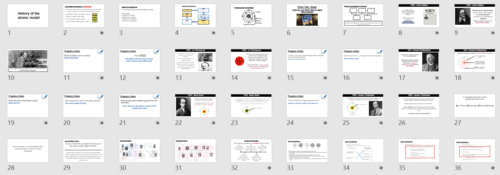5Uploads
259Views
48Downloads
All resources

Energy Stores and Transfers KS3
This lesson is designed for the KS3 Year7/8 unit on ‘Energy Stores and Transfers’ (two lessons).
The lesson begins with a DO NOW task; name the ways energy can be stored.
Next, students are introduced to what is energy and lets use money as a model to help us understand energy.
Students are then introduced to the 8 energy stores; Nuclear, Chemical, Magnetic, Gravitational, Kinetic, Thermal, Elastic and Electrostatic and provided with a mnemonic. Students are to then complete a knowledge check.
Law of conservation is introduced and students are then introduced to energy transfers with a number of different examples provided.
The plenary quiz is a nice way to summarise what they have learned in this lesson.
All resources apart from worksheets are included, thanks for looking, if you have any questions please let me know in the comments section and any feedback would be appreciated :)

Energy In Food KS3
Enhanced Lesson Resource for KS3 Physics
This lesson resource is an excellent tool for teaching KS3 Physics, specifically focusing on the energy content of foods and fuels. It is fully differentiated and provides a comprehensive learning experience for students. The resource aims to introduce the concept of energy by allowing students to compare the energy content in foods and fuels with the energy required for various activities.
Key Features of the Resource:
Engaging Lesson PowerPoint: The resource includes a detailed and visually engaging lesson PowerPoint that guides students through the topic effectively.
Differentiated Activities: To cater to students with varying learning abilities, the resource offers differentiated activities that help reinforce understanding.
Activity Sheets: Supplementary activity sheets are provided to support student learning and encourage active participation.
Practical Activity Worksheet: An optional practical activity worksheet is included, allowing students to conduct experiments to investigate the energy content of food firsthand.

Renewable Resources KS3
Perfect Lesson Resource for KS3 Physics
This lesson resource is designed to be an ideal tool for teaching Physics to KS3. It is fully differentiated and resourced, meaning it caters to students with varying levels of understanding and abilities. The focus of this lesson is on renewable resources, a crucial topic in today’s world given the increasing importance of sustainable energy sources.
During this lesson, students will delve into the pros and cons of different energy sources, with a specific emphasis on renewables versus fossil fuels. By exploring the advantages and disadvantages of each type of energy, students can develop a deeper understanding of the impact these sources have on the environment, economy, and society as a whole.
The resource package includes a detailed and engaging lesson PowerPoint with differentiated activities to cater to various learning styles. It incorporates elements such as quick starter activities, unlock keywords exercises, think-pair-share activities for collaborative learning, whiteboard/cold calling knowledge checks for assessment purposes, and a plenary session to wrap up the lesson effectively.
Worksheet for Student Engagement
To enhance student engagement and reinforce learning outcomes, a worksheet is included for students to complete either during or after the lesson. This hands-on activity provides an opportunity for students to apply their knowledge and consolidate their understanding of renewable resources and related concepts covered in the lesson

Fossil Fuels KS3
Enhanced Lesson Resource for KS3 Physics
This lesson resource is an excellent tool for teaching KS3 Physics, specifically focusing on fossil fuels and power stations. It is fully differentiated and well-resourced to cater to the varying needs of students.
Key Features of the Resource:
Detailed Lesson PowerPoint: The resource includes a comprehensive and engaging lesson PowerPoint that covers the topic effectively.
Differentiated Activities: The activities provided are tailored to different learning levels, ensuring that all students can engage with the material.
Clear Learning Objectives: The resource outlines clear learning objectives to guide students through the lesson.
Unlock Vocab Slide: This feature helps students focus on key terminologies used in the lesson, aiding in their understanding of the subject matter.
Recall of Energy Stores: Building on previous lessons, this resource includes a recall of energy stores to reinforce learning continuity.
Whiteboard/Book Activities: A variety of activities are included, such as whiteboard tasks and book exercises, to keep students actively involved in the learning process.
Think, Pair, Share Tasks: These tasks encourage collaborative learning and critical thinking among students.
Consolidation Task: A consolidation task is provided towards the end of the lesson to reinforce learning outcomes. Alternatively, teachers can insert their own worksheet at this point.
Tue or False Plenary: The resource wraps up with a true or false plenary session to assess student understanding and retention of key concepts.
This lesson resource is designed to enhance student engagement, promote active participation, and facilitate a deeper understanding of the topics covered in KS3 Physics curriculum.

KS4 History Of The Atom
Fresh content available for the AQA GCSE 1-9 Combined Trilogy Unit ‘C1 Atomic Structure’.
Complete lessons prepared for immediate use. The lesson fulfills all requirements for this unit, starting with an introductory activity, introducing key vocabulary, engaging students in collaborative thinking, delving into the history of the atom, guiding students to create a timeline, and applying knowledge to exam-style questions. Minimal adjustments required.





